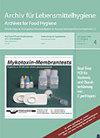不同贮藏温度下食用鸡蛋中沙门氏菌的生长研究
IF 0.2
4区 农林科学
Q4 CHEMISTRY, APPLIED
引用次数: 2
摘要
在德国,沙门氏菌病是人类最常见的食源性感染之一。受污染的食用鸡蛋是感染的主要来源之一。这项研究的目的是获得实验数据,以了解温度条件对在实际条件下可能发生的食用鸡蛋中的肠炎沙门氏菌行为的影响。为此,170个新鲜鸡蛋在不同温度下保存(A组:5℃;B组:25°C, C组:25°C/5°C,间隔3天交替进行)。在接下来的30天内,每隔6天进行定性和定量检查以检测SE。接种到蛋白中的沙门氏菌在整个研究期间均可检测到,即未灭活;然而,只有在5℃的贮藏过程中,SE才没有生长。经定性检验,SE可检出,在25°C或变温(25°C/5°C)贮藏期间,证实有相当数量的细菌生长。交替贮藏温度下,鲜蛋中沙门氏菌的迁移率最高(64%),但温度变化对鲜蛋中沙门氏菌的检测和浓度没有额外影响。这项研究表明,鸡蛋下蛋后应立即冷藏;建议保存温度= 5℃。本文章由计算机程序翻译,如有差异,请以英文原文为准。
Studies on the growth of Salmonella in table eggs under different storage temperatures
In Germany salmonellosis is one of the most common foodborne infections in humans. Contaminated table eggs are one of the main sources of the infection. The aim of the study was to obtain experimental data on the impact of temperature conditions on the behaviour of Salmonella Enteriditis (SE) in table eggs which may occur under practical conditions. For this purpose, 170 fresh eggs were stored at different temperatures (group A: 5°C; group B: 25°C, group C: 25°C/5°C in alternating sequences of three-day intervals). Every six days, qualitative and quantitative examinations to detect SE were carried out during the following 30 days. Salmonella, which were inoculated into the albumen could be detected over the whole study period, i.e. it was not inactivated; however, only during storage at 5°C, there was no growth of SE. By qualitative examination, SE could be detected testing, a considerable bacterial growth was confirmed during storage at 25°C or changing temperatures (25°C/5°C). By alternating storage temperatures, the highest migration rate into the yolk could be detected (64%), But changing temperatures had no additional effect on the detection or concentration of Salmonella in fresh eggs. This study shows that eggs should be chilled immediately after laying; a storage temperature of = 5°C is recommended.
求助全文
通过发布文献求助,成功后即可免费获取论文全文。
去求助
来源期刊

Archiv Fur Lebensmittelhygiene
工程技术-毒理学
自引率
0.00%
发文量
0
审稿时长
>12 weeks
期刊介绍:
The "Journal of Food Safety and Food Quality“ provides a platform for papers including case studies and discussion papers dealing with topics from all areas of food hygiene (food originating from animals) including dairy hygiene, food monitoring, beef cattle and meat examination, meat hygiene and food technology.
 求助内容:
求助内容: 应助结果提醒方式:
应助结果提醒方式:


